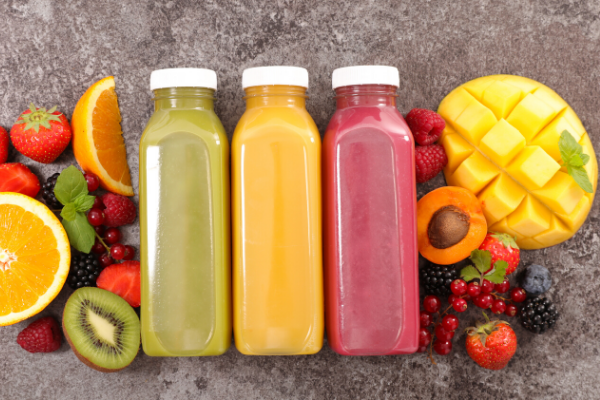
If you are looking for some of the healthiest and most nutritious juices on the planet, you should look no further. This article will cover health benefits, antioxidant sources, the Glycemic index and some precautions you need to take before you juice fruits. Here are the best fruit juices to get you started. The benefits of fruit juices are countless and can’t be argued with.
Health benefits of fruit juices
Various studies have shown that fruit juices can contribute to type 2 diabetes. However, these studies have also found that fruit juices have less fiber than whole foods and a higher glycemic index, which measures how quickly foods raise your blood sugar levels. Fruit juices do not have the same filling effect as whole fruits, so people tend to drink more juice than they would eat. However, juices can replace beneficial liquids such as water.
One study found that children who drank six-ounce bottles of orange juice had 18 grams of sugar per serving. A single can of soda has the same amount of sugar. It is therefore wise to limit fruit juice consumption for children under six years of age and to avoid it altogether for those who are obese or overweight. Juices can feed the bacteria that cause cavities and lead to tooth decay. Regardless of the age of the child, it is important to remember that fruit juices can contribute to obesity and diabetes. So, if you’re worried about the effects of juice on health, you should stick to fresh fruit and vegetables.
Drinking fresh fruit juices can provide temporary sustenance on the go. Juicing has become a popular trend among health buffs and celebrities. Freshly squeezed fruit juices are tasty and easy to digest. They are also perfect for the busy life that we lead today. If you’re worried about the sugar content of fruit juice, you can also drink it with your meals. A glass of apple juice contains almost three grams of soluble fiber.
Sources of antioxidants in fruit juices
Fruit juices contain a variety of antioxidants including tocopherols, tocotrienols, phenolic acids, and flavonoids. These are all good sources of antioxidants that can help live a healthy and safe life. But when it comes to consuming these natural antioxidants, the intake of fruit juices may be insufficient. As with other food sources, consuming fruit juice daily may not be sufficient. You should consult a physician if you suffer from any condition and if you are taking any medications.
It’s best to choose whole foods instead of fruit juices as they contain the same amount of antioxidants. This way, you’ll get the full benefits of all phytonutrients. Whole food packages contain antioxidants as well as other essential vitamins and minerals. Fruit juices also contain water, fiber, and naturally occurring sugars, so they’re not only tasty but good for your health.
The amount of phytonutrients found in juices will vary depending on how it’s processed. The more colorful the fruit, the more antioxidants it contains. That’s one reason why juices made from colorful fruits are better for you. For example, pink grape juice contains beta-carotene, which is a powerful antioxidant that protects the body from free radical damage. And pomegranate juice is loaded with antioxidants, making it a good replacement for other beneficial liquids.
Free radicals are unstable chemicals that attack body cells. These chemicals are linked to a wide range of diseases. Antioxidants can prevent the damaging effects of free radicals by neutralising them. Antioxidants in fruit juices are not as effective as those found in fruit juices, so the best thing to do is to drink plenty of fruit juices. The vitamins and minerals are found in fruit, vegetables, wholegrains, nuts, and meats.
Glycemic index of fruit juices
If you’re looking for a way to eat more fruits without increasing your risk of type 2 diabetes, knowing the Glycemic index of fruit juices may be a good start. A recent study has linked fruit juice to an increased risk of developing type 2 diabetes. While there are no direct links between fruit juice and diabetes, many studies agree that eating fruits that increase your risk of the disease is not a good idea.
Fortunately, the Glycemic index of fruit juices can be easily checked by comparing the sugar content of different types of fruit. Juice is typically made by squeezing out the fruit’s skin and seeds. While the juice contains a small amount of carbohydrates, it’s important to note that it’s likely to be higher than the whole fruit. According to the University of Plymouth’s Gail Rees, a senior lecturer in human nutrition, the fruit’s seeds may be the culprit in the results. The results of this study make it difficult to give clear advice, but she points to current advice of 150ml of fruit juice per day.
Most fruits are low to moderate on the GI scale. However, there are some fruits with a high GI, including watermelon and pineapple. While this may not be an ideal choice for everyone, it is an excellent way to add a little bit of fruit to your diet while maintaining a healthy weight and preventing the development of diabetes. A balanced diet of fruits and vegetables will allow you to get all the nutrients you need while limiting your risk of developing diabetes.
While fruit juices contain some benefits, their sugar content generally outweighs them. For example, juice is an excellent source of vitamin C, but it’s much better to eat leafy greens and veggies rather than fruit juice. Moreover, whole fruit has soluble fibre, which improves digestion and slows the increase of blood sugar levels. Despite its low GI, the juice still contains high levels of fructose.
Precautions for juicing
There are several precautions you should take when juicing fruit. Although consuming fresh fruit and vegetables is generally healthy, extracted juices contain little nutritional value compared to eating the fruit or vegetables themselves. However, juicing is a convenient way to incorporate more fruits and vegetables into your diet. Juicing is a good way to drink a healthy beverage that contains phytonutrients and fiber, which may help you feel full longer. Nevertheless, you should still consult with a doctor before consuming fresh juices, as there are a number of potential risks to health.
Untreated juices may contain harmful bacteria. These bacteria may get into the juices or cider, which are then consumed. Several cases of foodborne illness have been reported by the U.S. Food and Drug Administration. Considering the risks involved, you should choose fresh fruits and vegetables that are certified organic. Organic juices may be more nutritious, but they may contain residues from pesticides.
Many fruits and vegetables can cause problems if you are allergic to their nutrients. Some of these foods have higher sugar content than others, so it’s important to avoid them if possible. In addition, it’s important to choose organic fruit and vegetables. Because they contain more sugar than vegetables, they can harm your body if consumed in excess. Juicing fruit may lead to harmful effects if your kidneys are impaired.
Before you start juicing fruit, you should carefully inspect your juicer. The juicer’s blades are often infected with pathogenic bacteria and should only be cleaned properly before each batch of juice. Moreover, your juice should be consumed the same day, or else you could risk developing a foodborne illness. So, always remember to follow proper precautions for juicing fruit to ensure your safety.
Safety of juicing
Although there is no federal law that prohibits the sale of fruit and vegetable juices, there are some concerns about the process of juicing. Among other concerns, fruits and vegetables may be contaminated before they are juiced, exposing consumers to food-borne pathogens. Fortunately, there are some steps juicers can take to ensure their products are safe to ingest.
For example, heavy metals are a common concern with juicing, but their levels are very low. Juices contain heavy metals, including lead, which are linked to heart disease and high blood pressure. The government has set limits for these chemicals in juice, and some manufacturers limit their levels to a safe level. The best way to ensure the safety of your juice is to check labels and avoid buying juice from a store that does not label its products.
Another way to ensure that you juice is safe is to wash your hands thoroughly. Even if it is made from fresh produce, you should always wash your hands before cutting them. The juice itself can be contaminated with bacteria, and you shouldn’t risk catching food-borne illness by consuming it. Just be sure to bring the juice to a boil before serving it. There are some juices that have been pasteurized and may be safe for consumption, but not those that have been raw. If you’re not sure, consult a medical professional.
The safety of juicing for a healthy life depends on how you prepare the juice. Buying pasteurized juice is the safest option. Juice that has not been pasteurized has a low nutrient content and may be contaminated with bacteria. Those with compromised immune systems should avoid drinking juice that has not been pasteurized. If you drink juice from a restaurant, you are taking a much lower risk than if you bought it in a store.



